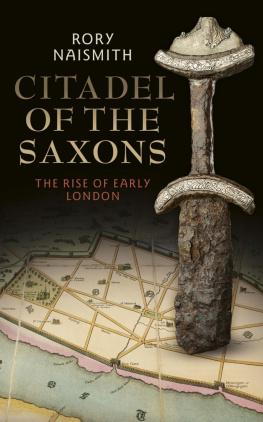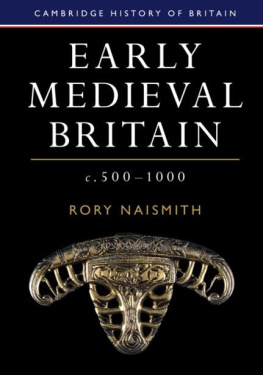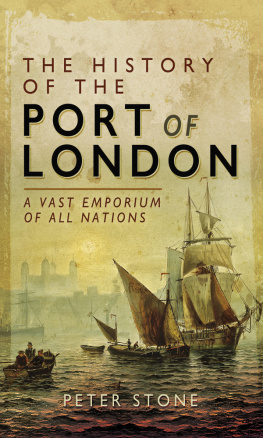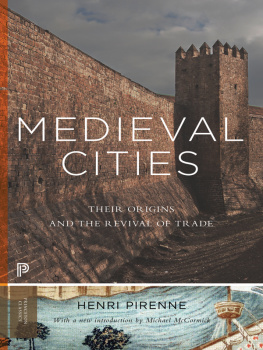
A Fellow of the Royal Historical Society, Rory Naismith is Lecturer in Medieval British History at Kings College London. His earlier books include Money and Power in Anglo-Saxon England (2012), which in 2013 won the Best First Book Prize of the International Society of Anglo-Saxonists.
Rory Naismith in his new book displays remarkable control of an extraordinarily diverse range of evidence and constructs a narrative with many unfamiliar details and dimensions. His story begins in Roman Britain, and extends here to the Norman Conquest of England in 1066. By virtue of its position on the river Thames, and at the hub of a network of roads, London continued to prosper throughout the Anglo-Saxon period. It was always, the author shows, at the centre of events and was renowned too as a significant centre of commerce. From the foundation of St Pauls to the building of Westminster Abbey, Dr Naismith ably and authoritatively guides the reader through all the citys twists and turns, while at the same time bringing to life a rich supporting cast of Mercians and West Saxons, English and Danes. This is an original and compelling account of early London.
Simon Keynes, Elrington and Bosworth Professor of Anglo-Saxon, University of Cambridge
No one can know yet to what degree Brexit will affect the fortunes of Englands capital. But Rory Naismiths riveting history of Anglo-Saxon London is a reminder of how despite all that the city suffered during its first millennium, and the rivalries with which it had to contend it survived such that possession of it emerged as the key to power during the Norman Conquest. Sacked by Boudicca in the first century, deserted by the Romans in the fifth, economically outdone by Ipswich in the seventh, and overshadowed both by the metropolitan status of Canterbury and York and by the royal glamour King Alfred and his successors bestowed on Winchester, London nonetheless emerged in 1066 as the place where Duke William needed to be accepted and where it was essential for him to stage his coronation. The strength of Rory Naismiths narrative derives from his mastery of the disparate sources needed to understand Londons developing success. The authors deep knowledge of the complexities of Anglo-Saxon coinage is matched in this book by an acute sense of the importance of the recent archaeological discoveries that have revealed how the city took shape within, and beyond, and then again within its ancient Roman walls. Anyone who loves London that place of the overflowing river (which is probably the ancient meaning of its name) will want to buy this superb book.
Henrietta Leyser, Emeritus Fellow and Former Lecturer in History,
St Peters College, Oxford, author of A Short History of the Anglo-Saxons and of Beda: A Journey Through the Seven Kingdoms in the Age of Bede
Citadel of the Saxons is the first comprehensive treatment of Anglo-Saxon London. Rory Naismith ranges widely across archaeology, coinage and written sources showing an impressive command of multiple sub-disciplines in the process to piece together a fresh picture of the early medieval metropolis. Engagingly written yet authoritative, this is everything a history book should be!
Levi Roach, Senior Lecturer in Medieval History,
University of Exeter, author of thelred: The Unready

Published in 2019 by
I.B.Tauris & Co. Ltd
London New York
www.ibtauris.com
Copyright 2019 Rory Naismith
The right of Rory Naismith to be identified as the author of this work has been asserted by the author in accordance with the Copyright, Designs and Patents Act 1988.
All rights reserved. Except for brief quotations in a review, this book, or any part thereof, may not be reproduced, stored in or introduced into a retrieval system, or transmitted, in any form or by any means, electronic, mechanical, photocopying, recording or otherwise, without the prior written permission of the publisher.
Every attempt has been made to gain permission for the use of the images in this book. Any omissions will be rectified in future editions.
References to websites were correct at the time of writing.
ISBN: 978 1 78831 222 6
eISBN: 978 1 78672 486 1
ePDF: 978 1 78673 486 0
A full CIP record for this book is available from the British Library
A full CIP record is available from the Library of Congress
Library of Congress Catalog Card Number: available
Text design and typesetting by Tetragon, London
I long to go through the crowded streets of your mighty London, to be in the midst of the whirl and rush of humanity, to share its life, its change, its death, and all that makes it what it is.
Bram Stoker, Dracula
Contents
- Between a Rock and a Hard Place:
London, Alfred and the Vikings from c. 880
Abbreviations
ANS Anglo-Norman Studies .
ASC Anglo-Saxon Chronicle . This is the modern term for a group of Old English chronicles covering the period 60 BC AD 1154. The eight principal surviving manuscripts are traditionally referred to using the letters AH, with substantial variations among them, though all descend from a compilation made c.892. When there is no substantive variation, the year alone is given (a second year in brackets indicates the year given at a time of chronological dislocation in the chronicle). For translation, see The Anglo-Saxon Chronicle: A Revised Translation , trans. Dorothy Whitelock, David C. Douglas and Susie I. Tucker (London, 1961).
ASE Anglo-Saxon England .
ASSAH Anglo-Saxon Studies in Archaeology and History .
ASWrits Anglo-Saxon Writs , ed. F. E. Harmer (Manchester, 1952).
BCS Cartularium Saxonicum: A Collection of Charters Relating to Anglo-Saxon History , ed. Walter de Gray Birch, 3 vols (London, 188599).
CantCC The Charters of Christ Church, Canterbury , ed. N. P. Brooks and S. E. Kelly, 2 parts (Oxford, 2013).
CantStA Charters of St Augustines Abbey, Canterbury, and Minster-in-Thanet , ed. S. E. Kelly (London, 1995).
Chert Charters of Chertsey Abbey , ed. S. E. Kelly (Oxford, 2015).
DOE Dictionary of Old English (University of Toronto: www.doe.utoronto.ca/ ).
EHD English Historical Documents, vol. 1: c.5001042 , ed. Dorothy Whitelock, 2nd ed. (London, 1979).
EHR English Historical Review .
EME Early Medieval Europe .
GDB Great Domesday Book. References are to folio number in Domesday Book , ed. John Morris et al., 35 vols (Chichester, 197386), but many other editions are available.
Glast Charters of Glastonbury Abbey , ed. S. E. Kelly (Oxford, 2012).
HE Bede, Historia ecclesiastica gentis Anglorum ( The Ecclesiastical History of the English People ).
K Codex Diplomaticus vi Saxonici , ed. John M. Kemble, 6 vols (London, 183948).
LondStP Charters of St Pauls, London , ed. S. E. Kelly (Oxford, 2004).
MGH Monumenta Germaniae Historica.
PAS Portable Antiquities Scheme ( www.finds.org.uk ).
Pet Charters of Peterborough Abbey , ed. S. E. Kelly (Oxford, 2009).
RIB R. G. Collingwood and R. P. Wright, The Roman Inscriptions of Britain (Oxford, 1965). See also R. G. Collingwood and R. P. Wright, The Roman Inscriptions of Britain 2: Instrumentum Domesticum , ed. Sheppard Frere and R. S. O. Tomlin (Oxford, 19905); R. S. O. Tomlin, R. P. Wright and M. W. C. Hassall, The Roman Inscriptions of Britain 3 (Oxford, 2009); and romaninscriptionsofbritain.org.










